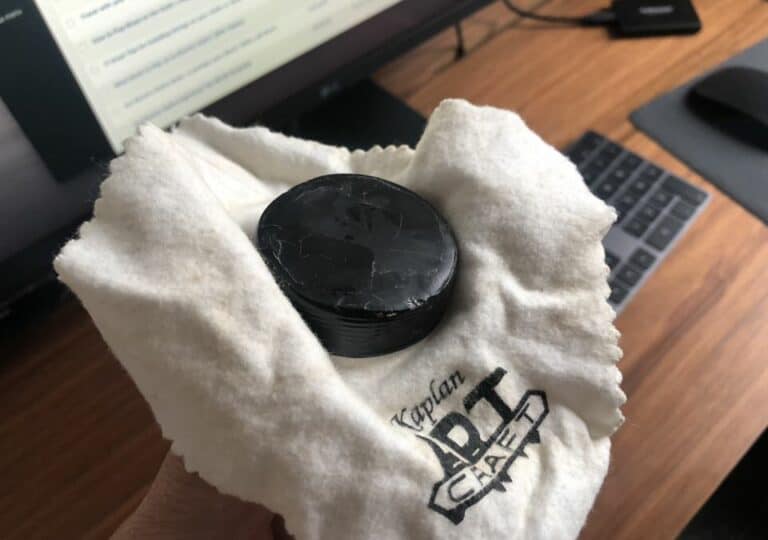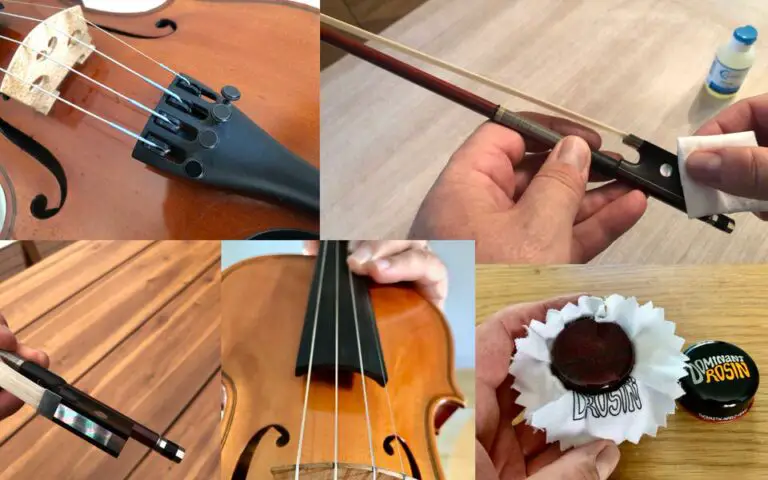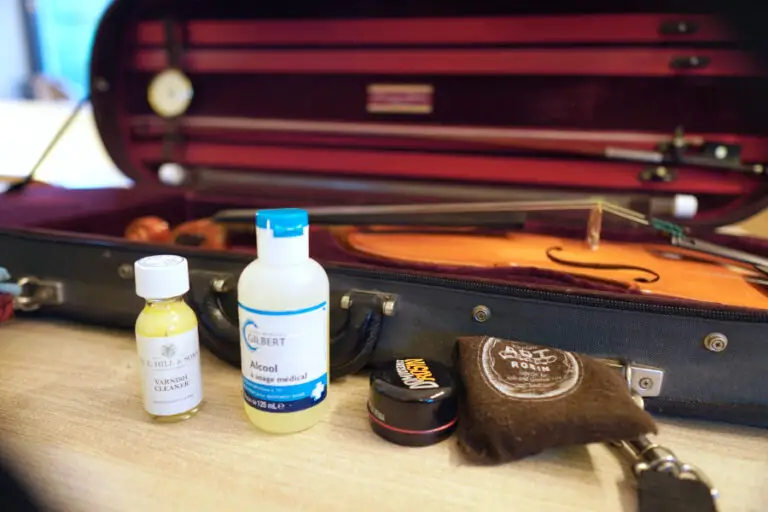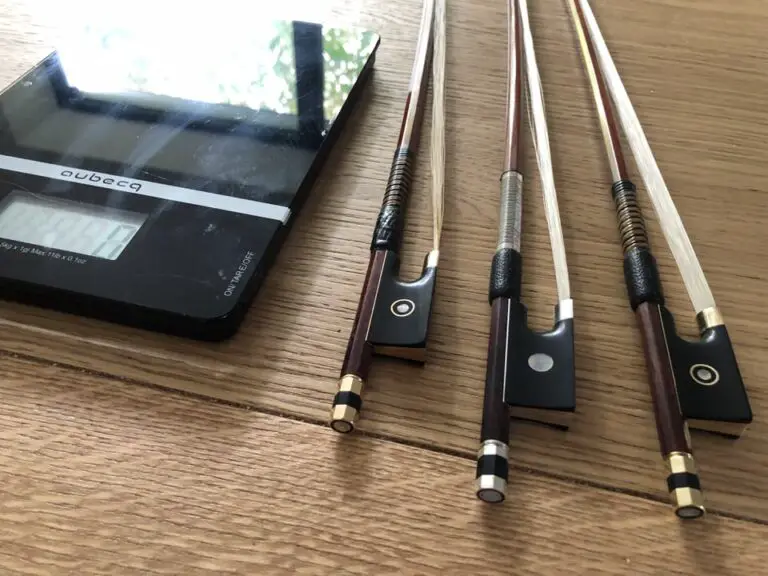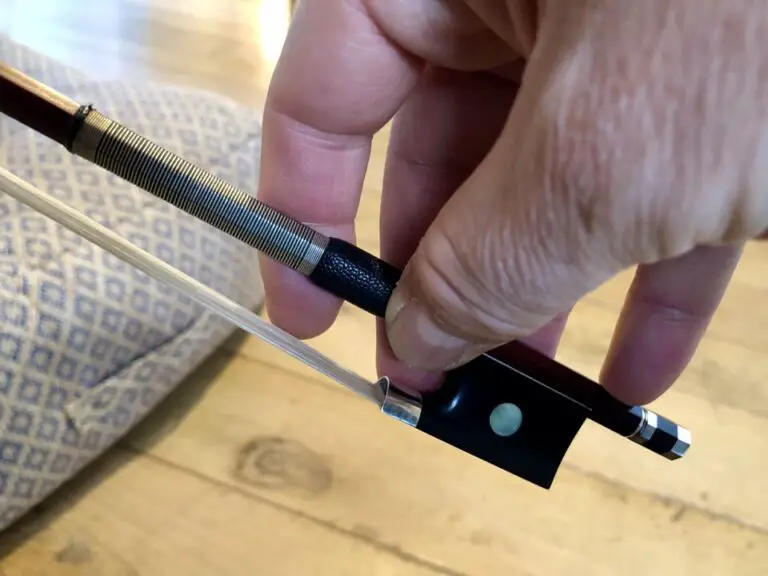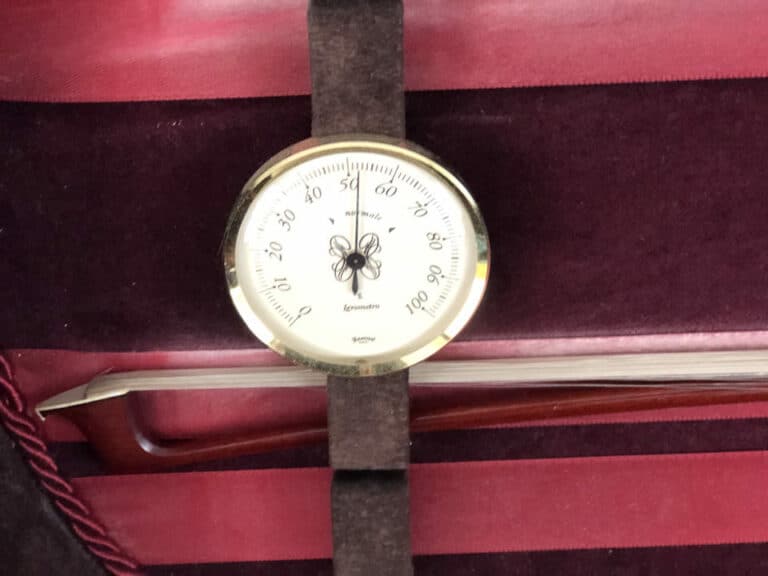How to Tighten a Violin Bow: Please don’t break it!
The bow of a violin is called a bow for obvious reasons: it is made of a stick of wood and a rope (hair) with tension. The role of the tension is twofold: it allows the hair to adapt to the string’s shape easily, something a hard surface won’t do as well. Plus, with its natural rebound, the bow allows the player to perform many types of sounds, bow strokes, such as saltellato, spiccato, staccato, which consist of many short and fast small notes that would be impossible to play otherwise.
That is why tightening your bow properly is crucial for a good technique and to perform your hard-learned tunes properly.
So, how to tighten your violin bow?
To tighten your bow, turn the button clockwise a couple of turns until there is just enough room for a pencil to fit in the middle of the bow. The hair shouldn’t touch the stick when you play. If you can’t see the camber of the stick anymore: the bow is too tight. Always loosen your bow completely after each use.
Several parameters can influence how to tighten a bow, and how often. And it can sometimes become harder to tighten, and even remain loose. So read on, I will cover all those instances as well.
Table of Contents
Simple steps to tighten your violin bow
Each time you practice or play your instrument, you need to tighten your bow. Even if it is a bit intimidating to beginners, it is straightforward provided you follow the steps.
4 simple steps to tighten your violin bow
- Turn the button of the bow clockwise until the hair separates from the stick,
- Check that there is enough room to fit a pencil between the hair and the stick at the middle of the bow,
- If there is enough tension, the stick will start to lose a bit of its camber and the pencil will fall,
- If there is too little tension, the pencil won’t move at all.
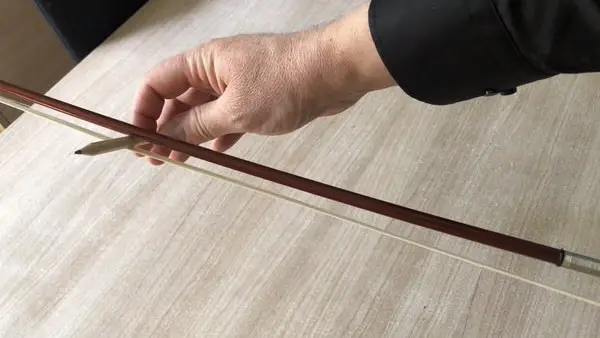
After the pencil has fallen off, I prefer to loosen the bow slightly.
If you are a beginner, maybe tighten your bow a bit less, and then tighten a bit more if the stick touches the string.
If you are advanced, maybe tighten your bow a bit more because you will have to play chords that require more pressure.



Simple tips to help beginners tighten their bow
Beginners will have a tendency to over-tighten their bow. With a feeling that the more you tighten your weapon, the stronger you will play. They usually turn that button a turn too much; there is more than a pencil’s worth of space between the hair and the stick; the bow doesn’t show its camber anymore.
How advanced violinists and virtuosi do tighten their bow?
Advanced violinists have to tighten their bow a bit more because they play in so many different situations where a big sound and many chords are needed.
The bow will naturally change its tension by itself, with the differences in atmospheres: from cold to hot, from dry to humid. During a concert, if the room or hall is hot, if the violinist sweat, the tension of the bow will change over time and won’t settle.
Good violinists do not fear adjusting the tension of their bow all the time.
You play a passage of many chords forte, then you go to a fast passage of short and bouncy small saltellato strokes piano: you need to quickly loosen your bow a bit.
Some virtuosi are known to play with so much tension that they damage their bow. Again, they need to fight a big romantic orchestra in a giant hall. They play with a lot of arm weight, very big and fast bow movements to get a giant sound; this is exceptional. Do not shoot for that.
What if my bow is too tight?
The risk of having a too tighten bow is mainly:
- Your sound will be tighter; if you are a beginner, it will be more difficult to play long notes with a good sound. The stick might shake and transmit that movement to the hair and to the sound. If you are an intermediate player, you will find it more difficult to play chords, especially at the frog, with a bow too tight. You need to “coat”, or to “wrap” the strings with the hair of the bow. It will be easier with smooth and adaptable hair than a hard one.
- You risk damaging your bow in the short term. The head might just break off. Or the stick somewhere if it has a weaker point. That is not what you want.
- You risk to stretch the hair; it will become slightly longer and less bouncy; the only solution then is to have your bow re-haired which will cost you some time and money.
- You risk damaging your bow in the long term. It will lose its camber and its bounciness. It will be less stable. You will find it more and more difficult to perform those springy bow strokes (saltellato, spiccato) that are so important to many pieces. The only option you will have is to go to a bow-maker and have the bow heated up and re-camber. But it is easier said than done. Some bows of lesser quality won’t be worth it; some types of wood won’t permit it. And you can’t do it so often. Sometimes, you will have to dispose of your bow and buy a new one. If your bow is pricy, you will regret it.
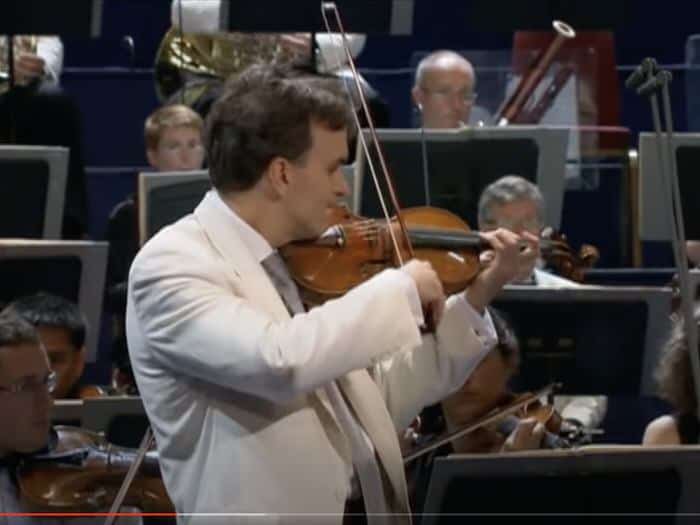
What if my bow is too loose?
If your bow is too loose, you won’t risk much. You will be able to play piano to mezzo-forte with a good sound. But when you will need to play forte, the hair of the bow will touch the stick.
Again, you won’t be able to play heavy chords on the middle of the bow; spiccato will be impossible without touching the stick from time to time.
Some modern pieces like this stick-to-string kind of sound, but otherwise it is to avoid.
You won’t damage your bow like that. Except for the sound, there is nothing to fear with a bow too loose. You will have to clean the part of the stick that gets in contact with the hair because it will be white with rosin quicker.
When you are a beginner, it is recommended to tighten the bow not too much as a precaution, and tighten it slightly more as soon as you feel that the stick has touched the string.
How to loosen your violin bow
After each time, always loosen your bow completely. By completely, I mean until there is no more tension, then loosen a bit more. Because of differences in temperatures, a loose bow might find still a bit of tension and damage the hair if you store it for a long time.
By loosening the tension you will save both:
- the stick, which will keep its bounciness, will remain springy and nimble as designed by the bow maker. These qualities are so rare, they should be preserved at all costs.
- the hair. Hairs won’t break so often. You won’t need to have your bow re-haired for a longer time.
A top tip is to help the frog slide by pushing it towards the tip of the bow with your left thumb while unscrewing with your right hand. That way, you won’t rely only on the strength or the stick and the force of the screw: you will save wear and tear to the thread and be sure to loosen the bow completely.
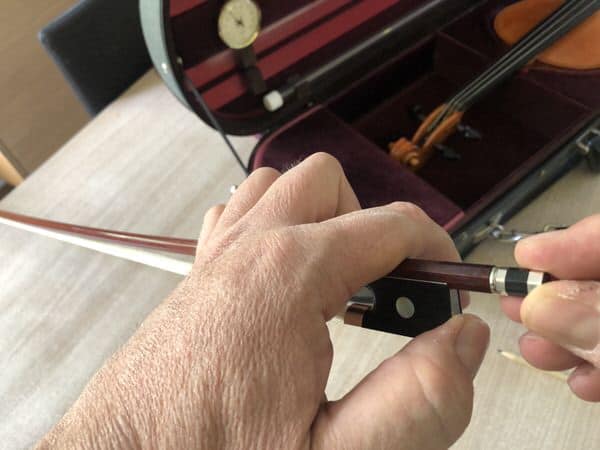
How to fix a violin bow that won’t tighten
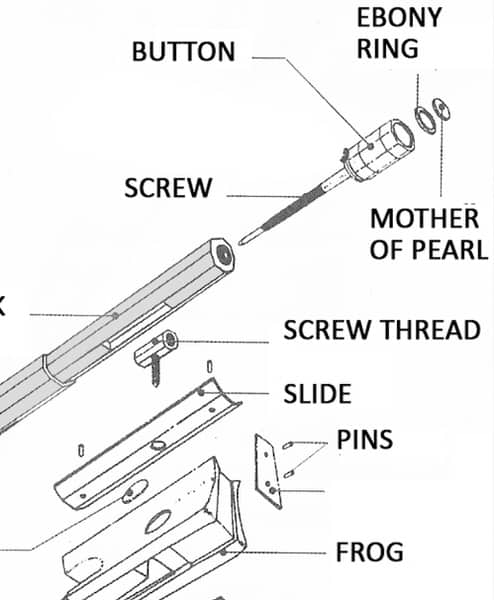
If the bow won’t tighten and the screw turns loose, then chances are that the screw thread inside the frog is worn out. There is not much you can do by yourself, except temporarily with some Teflon tape.
You can put a bit of Teflon tape on the screw and hope it will give it a bit of traction in an emergency before that important concert (but you should always have at least two bows with you). Do not put glue, because you won’t be able to loosen your bow and change hair without damaging it.
If your bow is valuable enough, a bow-maker will repair that and change the screw thread for you.
How to tighten violin bow hairs that stay loose
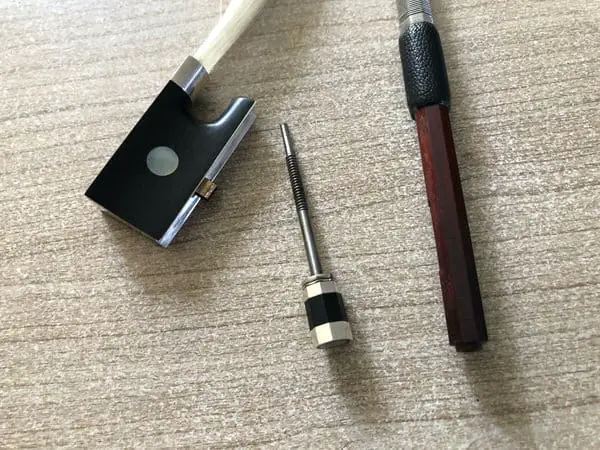
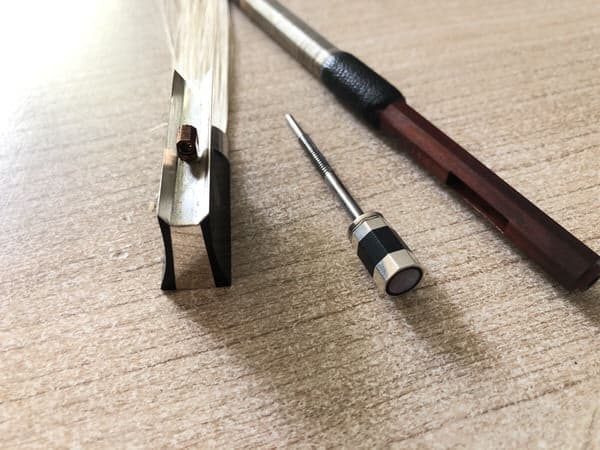
If when you tighten your bow, some hairs stay loose, the only thing you can do is to cut them if there aren’t too many of them. When you cut individual hairs, do not pull too strongly on them. Instead, especially if you are at home, prefer to cut it with good pair of scissors, or a razor-sharp knife, close to the head or the frog.
But loose bow hairs are usually the sign of a bow hair that needs to be replaced. If it doesn’t happen too often though, then you can keep on playing with that hair, but consider changing it in a short timeframe.
What to do if it is hard to tighten a violin bow
You can’t turn the button, or it is very hard. There might be some rust on the screw. The challenge is to unscrew the button, clean the screw with a brass brush, and put some grease on it.
When you play, there is some natural moisture over time that goes into the frog of the bow. Even some sweat, which is corrosive. If you haven’t serviced your bow for a long time, or have it re-haired by a professional, then chances are the screw is rusted and stuck in the thread.
- Do not put any oil just yet as it can damage the wood. –
- You can apply some force when unscrewing the bow,
- Then take the screw out, clean it with a small metal brush, ideally a brass brush.
- Put a tiny amount of grease on the screw and put it back together;
Now that you know how to tighten and loosen your bow, here is how I recommend cleaning it.

